|
Vowels can be interpreted as d-degree steps or intervals,
with consonants as the fixed borders, according to one of
the views on these. Or vowels as a secondary field level
(4'), consonants as the quantifying, "substantiating"
force from lower d-degrees.
Cf. that vowels in writing of some languages
as Hebrew, were marked as dots or dashes under / over the
line of consonants, when they didn't belong to the pronunciation
of the consonant.)
Dimension steps implies also angular steps
type "180°—>
90°—> 45° ..."
according to hypotheses in our model, and differentiation
of vowels may be seen from this aspect:
Coordinate axes:
x-axis: windpipe —
lips: tongue back-/inwards, lips forward as in the o-sound,
<——>
y-axis: bottom —
ceiling of oral cavity: tongue downwards the bottom, jaws-lips
vertically opened as in the long a-sound
2.
z-axis: tongue in middle position, widened, jaws-lips
widened, as in the e-sound.
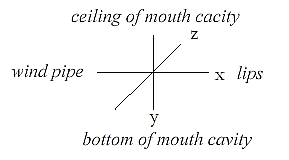
Phoneticians' classification of vowels, tongue
positions most critical:
Back —
Front*, here the x-axis, concerns tongue position horizontally.
Low —
High, here the y-axis, concerns tongue position in height
(= in "open" - "closed" vowels).
Rounded —
not rounded, (~ along the z-axis), concerns form of
lip opening
Long —
Short, time for the pronunciation, a differentiation
within the other characterizations above.
* Back vowels implies raise of tongue towards soft palate,
front vowels raise of tongue towards hard palate. Cf.
the file about consonants,
tongue contracted to a mass, ~ 3-dimensional, and more
flattened to a surface, ~ d-degree 2.
Number of vowel heights (hence vertically) in a language
can be up to 4, so it is said, but are often reduced in
numbers as 4 —> 3 —>
2.
Dimensional aspects when it concerns the speech organs,
a first sketch:
4: Direction outwards / inwards (posterior - anterior):
x-axis, opposition "180°". d-degree 4, <====>
.
3: Radial/ circular, tongue -
palate, height positions: y-axis, polarity "90°".
d-degree 3, __|__.
2: In the differentiation through shapes of lip-opening,
circular to elliptical, the z-axis is involved (see "Annotations"
below.)
(Mouth opening max about "45°
".) Note also that a convex/concave form of the tongue
- as poles of d-degree 2 in our model - separates vowels
e - i.
1: Long / short vowels: a polarization in mouth opening
and in the dimension of Time, corresponding to intermediate
stages in the 4 - 3 - 2-steps.
The vowels as step displacements, describing 90° arcs
in 3 planes:
(Sw.) for Swedish vowels.
Back, "rounded" vowels: long o,
long å (Sw), short å (or o),
"often" long a:
D-degree step 4 —>
3:
Long vowels o —>
å —> a
describes a an arc from the inner part of x-axis to the
y-axis, in xy-plane, equivalent with a polarization of the
x-axis 180° to 90°.
- Lips opening stepwise towards the y-axis.
- Tongue position stepwise lower.
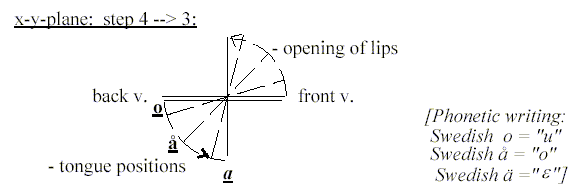
Front, "not rounded" vowels: short
a, short ä (Sw.), long ä, e:
D-degree step 3 —>
2:
short a —>
ä —> e
(—> i) describes
the arc from the y-axis to the z-axis, in yz-plane.
- Lips opening stepwise towards the z-axis. (About the i-vowel,
see below.
- Tongue position stepwise higher.
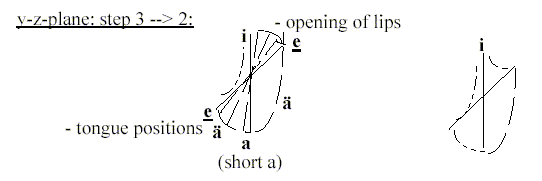
Front, "rounded" vowels: y -
u - ö (Sw.) - , open ö / u, about the
sound in English "early".
D-degree step 2 —>
1:
y —> u
—> ö —>
: Lip movements from z-axis back to x-axis, in zx-plane,
in one step, a return.
- Lip-opening stepwise then along the y-axis (a secondary
kind for y and ö: only lip- opening,
not the entire lower jaw).
- Tongue position from high in y lower and lower in following
vowels.
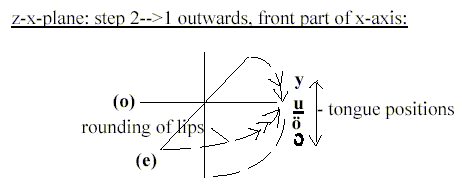
Annotations:
1) According to phoneticians (BM), following
pairs of vowels have the same tongue position in height:
 The difference is only "rounding" of the lips
in the y - ö - sounds.
The difference is only "rounding" of the lips
in the y - ö - sounds.
y- and ö-sounds as a polarization up / down
in tongue position in relation to the xz-plane:

The small lips opening in y and long ö-sound,
without opening of jaws, could illustrate the assumed narrower
angles towards lower d-degrees in a dimension chain.

2) Along the x-axis ("D4") there is a
double-direction tongue-lips in the o-sound, becoming a
unidirection in the u-sound, to compare with increasing
one way direction towards lower d-degree in the dimension
model.

The Swedish u-sound has developed from an inner
elevated position (as the o-sound also is described)
through a process in which the tongue has been pushed forwards.
Hence, the long u above may perhaps be regarded as having
the same tongue position as the o-sound.
All three steps according to the figures
above taken together can be regarded as a "pole exchange"
from d-degree 4 and inner pole 0 via steps →
3 → 2 →
1 to 00 as outer pole, and "the other way around"
to the x-axis again.
3) The i-sound is defined as the highest
vowel and the vowel articulated most in the front. It is
assigned to the group front, not rounded vowels: short a
- ä - e - i (from below upwards in tongue height
position), step 3 - 2, y —>
z-plane in our figures above.
In the series short a - ä - e however, steps
in height position of the tongue is combined with the form
of jaws and lips - stepwise closing to something of a "streak"
in the e-sound. The i-sound then hardly implies any
change in the jaws lips shape, only requires raising of
the inner organ, the tongue.
In this respect, the i-sound appear as
an expression for a branch from step 2-1 inwards step 3
- 2: 3 —> 1 <—2.
Formants of the i-sound are the
most polarized in the frequency spectrum. (Most polarized
- as in last step of a dimension chain, moreover designed
as a simple line with a dot over it as an illustration of
this last step!) The tongue raise from z-axis of e-sound,
depicted with dashed lines in figure y-z-plane above could
perhaps represent the formants?
(The reason why o- and i-sounds are described
as with the same high tongue position by phoneticians, depends
perhaps upon the palate being narrower inwards - a relative
determination of the height?)
4) The "development" from back towards
front vowels as in a step 4 →3
to 3 → 2 to 2 →
1 coincides with the interpretation of consonant developments
3-2 —> 2-1: plosives
→ fricatives in the transformation
(in Swedish) of back plosives to fricatives when preceding
front vowels: ke, kä, ki.. They transform to
fricative sounds, here typed "tje". and the plosive
g becomes a j-sound. This transformation however,
doesn't occur before the u-sound, developed out of
a back vowel a more direct way.
Note the term "soft vowels"
for the front ones, which with the dimension model could
refer to less structure, more motional moments) in lower
d-degrees.
5) 3 series of vowels, if all with 4 vocal heights:
4 + 4 + 4:

(Special signs are those of phoneticians, but Swedish o,
u, å-letters used.)
Circular arches of "90° " between the coordinate
axes, according to the principle schedule above, will be
divided by number of vowel heights in each series. It gives
an "angle" of about "30° " on average.
4 vowel heights and 3 steps:
(Sin "30°" = 1/2, sin "60°"
= √ 3/4; tan "30°"
= √ 1/3, tan 60° = √ 3.
Vowel heights as sin-cos-tan functions and roots out of
d-degrees and quotients between d-degrees!)
6) The terms "rounded - not rounded" vowels
can be discussed. It could be argued, as in the figures
above, that it is the direction of lips outwards along the
x-axis that characterizes the o-sound, and the motions
of lips and jaws in vertical direction, along the y-axis,
that characterizes the transition to a long a-sound.
The rounding of lips opening could be
perceived as merely an indirect consequence of these straight
directions, when the mouth opening and lips happen to have
a horizontal position!
The front vowels, short a - ä
- e - i, which are called not rounded, are actually
a gradual transition from round to elliptical to more elongated
elliptical to "streak"-formed mouth opening.
Ellipses: the form of a circle when its
centre gets split to 2 focal points. Such forms as well
as "back rounded" vowels, may be regarded as secondary
results of the transition from y- to x-axis.
Compare Lissajou's figures
for geometries, created by particle rotations in 2 planes
simultaneously: the changes circular - radial - streak
forms.)
7) With phoneticians' description all back vowels
are rounded, the front vowels e - ä - short
a not rounded But in the last series y - u - ö
the rounding reappears - as a kind of "feedback",
also corresponding to the connection between steps in the
loop version of the dimension model:

"Rounding", if one accepts phoneticians' definitions,
becomes associated with x-y-axis, here representing "step
4 - 3" with reference to analysis of the organs. Compare
circular structure as geometry for the 3a-pole of d-degree
3 according the dimensional model.
—————————————
Some readers may ask how it's possible to find 4 and up
to 5 dimensions among phonemes when there is - "obviously"
? - only 3 dimensions or coordinate axes in the speech organs.
Physicians' answer would surely be: in the processes,
representing motions, thus Time. In our model: d-degree
0/00 of motions.
Other kinds of answers here:
Among consonants:
h-sound: - A deep sigh from
step 5-4. The body as the 5-dimensional whole, the underlying
level.
Among vowels:
A groan - with tongue totally
passive, irrelevant, not needed,
or - with closed lips - a kind of m-sound: A
moan...
Vibration of vocal cords as the motional
expression for d-degree 5 when transformed to d-degree 4.
Click-sounds, not treated here: implosion
versus explosion in stops. Expressions for he dual directions
of d-degree 4.
Morphemes
Some words about
syllables, morphemes, word stems
Number of phonemes in a syllable appears
to be of the order of 1-5 , usually 2-3; when more, they
are probably often contractions of original two or more
syllables. Maximum number perhaps given by an underlying
5-step structure?
About syllable boundaries, the learned are said to disagree.
The linguist Saussure wrote about the transition from direction
towards a consonant as "recharging" against a
barrier, to following explosive in direction outwards towards
the vowel "up>|<per": turn from directions
(Vconv - Vdiv) in terms of the dimension model - and a correspondence
to plosives on the level of phonemes.

The syllable boundary could represent the concept "discontinuity",
illustrated here in a little different way than the very
simple illustration of it in Physics I, a transition
from boundary to the interval:
Vowels along the "0-line", direction from 0 outwards.
Consonants as the quantifying 00-pole, meeting from outside
in different steps:

In some languages, two consonants cannot occur next to
each other, it is said.
Morphemes has been defined as the smallest group of sounds
carrying sense, connected or derived from the semantic level.
Number of syllables in a morpheme seems mostly
to be 1-2. This could be compared with our proposed positioning
of morphemes as in step 2 - 1 in the big chain for levels
in languages: the development from the meaning or sense
to a linear sentence.

If morphemes should be interpreted as syntheses of phonemes,
or the phonemes as decomposed from morphemes, can be discussed.
If two words or morphemes is crossed at right angles as
in crosswords, the "letter", the phoneme, gets
precipitated.
As examples show in section above: With
a dimensional interpretation of phonemes, as well as of
human situations and the environment, the individual sounds
cannot be denied connections with semantic sense either.
Compare Robert Beard (RB)
about earlier word stems with mostly geometrical sense that
have been reduced to a "parasitic existence".
As written in another file (?), it's said that Semitic
morphemes, the "smallest sense-carrying units",
consisted of 3 consonants, originally 2 defining the main
sense, developed with a 3rd that differentiated the sense
(LB).
Example: p-a-l-a-g = divide, p-a-l-a-h,
~ split up
Thus the basic form for a morpheme (and syllable) becomes
CVC, extended with VC, 5 phonemes. C = consonants, V = vowels.
An Indo-European consonant radical, type *brg (aspirated
b and g) gave words as berg, borg
(Swedish words meaning hill/mountain and castle/stronghold
(SEO).
Fiji language has had morphemes of the type CVC, a closed
type that now have become open and got the form CV. Thus,
3 —> 2 phonemes (BR).
Hence, we have 2 - 3 consonants or
phonemes for one sense - as there are 3 - 2 bases (nucleic
acids) in the codons for the identification of each
amino acid in the
genetic code - often described as a language.
However, in numbers it's the number of phonemes that
are of the same order as coded amino acids, and there
don't seem to be any simple parallel to the only four
bases. (Yet, it wouldn't be astonishing if there existed
some deep correspondence.)

The CV-type can be regarded as representing a first
polarization c - ac, 0 —>
00, outward direction from a barrier centre. The second
consonant in a CVC-morpheme provides a secondary barrier,
as the circumference of a circle relative the radius. CV
to CVC should, looked upon this way, imply an angle step
towards a lower d-degree, as a step 4 —>
3.
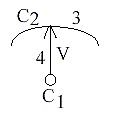
The relation vowel - consonant may be compared with verbs
as open, nouns as closed.
(CVC-morphemes with examples from Swedish:
s-a-k, (= thing).
VCC-morpheme a-s-k (= box), a noun, a closed
morpheme.
CCV: s-k-a, (= shall), a verb, an open morpheme.)
A development CVC to CV morphemes could perhaps be interpreted
as analogous to ionization of atom groups, vowels as "free
valences" for the capture of substitutions = other
consonants, e.g. H2O —>
OH- —> O-H-Cl.
Morphemes could appear out of small mini-groups or "bubbles"
of phonemes as a "molecular soup" (or similar
to first cells in an embryo?), out of a multidimensional
system and its plane and space quadrants, through partial
couplings between different coordinate axes and angle steps
- with phonemes decoded dimensionally. (Cf. what physicists
assume to be carriers of the strong force, the "gluons".)
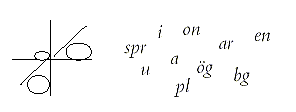
Different neurones could potentially be activated by different
geometrical properties of the steps in a dimension chain
(cf. how the eye analyzes visual stimuli: e.g. distance
to a centre (amplitude), vectors (direction), angles, ascending
/ descending lines, curves, etc.) They could in various
combinations correspond to phonemes or groups of phonemes,
and the network of connections between them evolve from
the hearing of language. A counterpart on the levels of
phonemes and morphemes to how the grammatical structure
also could be analyzed and stored?
"Word stem" or a "word bush"?
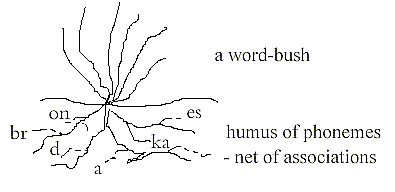
*
To Semantic
roles of phonemes
To Sound shifts
|




 The difference is only "rounding" of the lips
in the y - ö - sounds.
The difference is only "rounding" of the lips
in the y - ö - sounds.










